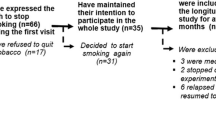Abstract
The purpose of this experiment was to compare independently the influence of different cigarette smoke taste categories and different machine standard smoke yield values on cigarette smoking behavior and related subjective measures. In six separate sessions 15 regular smokers were presented with a medium and a low smoke yield cigarette of each of the three taste categories, mentholated, dark (Gauloises) and blond (Muratti) tobacco. Each session, included a “natural” and a “forced” smoking procedure of one cigarette type only. Forced smoking consisted of smoking 30 puffs whereby a new half-length cigarette was presented after every third puff. During the seventh session, habitual brand cigarettes were smoked as a reference. The sessions followed in weekly intervals, and the subjects became familiar with the test cigarettes during the last 5 days preceding each test session. Although general acceptability of the cigarettes, smoking satisfaction and pleasantness of taste were clearly lower for all test cigarettes as opposed to the habitual brand reference, cigarettes, these measures remained unaffected by taste or smoke yield of the test cigarettes. Harshness of smoke was higher in the dark tobacco category and generally decreased with the lower smoke yield cigarettes. Independent effects of taste and smoke yield were obtained for total puff volume, inhalation time and CO absorption, suggesting a compensatory intensification of smoking behavior for low yield cigarettes and an independent increase of smoking intensity from mentholated to dark tobacco to blond tobacco. The results suggest therefore that factors which affect cigarette smoke taste have effects on smoking behavior which are separate from those obtained by comparing smoke yields.
Similar content being viewed by others
References
Adams L, Lee R, Rawbone R, Guz A (1983) Patterns of smoking: measurement and variability in asymptomatic smokers. Clin Sci 65:383–392
Bättig K (1981) Smoking and the behavioral effects of nicotine. TIPS 2:145–147
Bättig K, Buzzi R, Nil R (1982) Smoke yields of cigarettes and puffing behavior in men and women. Psychopharmacology 76:139–148
Benowitz NL, Kuyt F, Jacob P (1982) Circadian blood nicotine concentrations during cigarette smoking. Clin Pharmacol Ther 32:758–764
Buzzi R, Nil R, Bättig K (1985) Development of puffing behavior along burning time of a cigarette-no relation to alveolar inhalation or nicotine delivery of the cigarettes? Psychopharmacology 86:102–107
Creighton DE, Noble MJ, Whewell RT (1978) Instruments to measure, record and duplicate human smoking patterns. In: Thornton RE (ed) Smoking behavior. Physiological and psychological influences. Churchill Livingstone, Edinburgh London New York, pp 168–170
Gust S, Pickens RW (1982) Does cigarette nicotine yield affect puff volume? Clin Pharmacol Ther 32:418–422
Guyatt AR, Kirkham DC, Mariner DC, Cumming G (1988) Is alveolar carbon monoxide an unreliable index of carboxyhaemoglobin changes during smoking in man? Clin Sci 74:29–36
Herning RI, Jones RT, Bachman J, Mines AH (1981) Puff volume increases when smoking low nicotine cigarettes. Br Med J 283:181–189
Jaffe AJ, Glaros AG (1986) Taste dimension in cigarette discrimination: a multidimensional scaling approach. Addict Behav 11:407–413
McBride MJ, Guyatt AR, Kirkham JT, Cumming G (1984) Assessment of smoking behaviour and ventilation with cigarettes of differing nicotine yields. Clin Sci 67:619–631
Nil R, Buzzi R, Bättig K (1984) Effects of single doses of alcohol and caffeine on cigarette smoke puffing behavior. Pharmacol Biochem Behav 20:583–590
Nil R, Buzzi R, Bättig K (1986) Effects of different cigarette smoke yields on puffing and inhalation: is the measurement of inhalation volumes relevant for smoke absorption? Pharmacol Biochem Behav 24:587–595
Nil R, Woodson PP, Bättig K (1987) Effects of smoking deprivation on smoking behavior and heart rate response in high and low CO absorbing smokers. Psychopharmacology 92:465–469
Pomerleau OF, Fertig JB, Shanahan, SO (1983) Nicotine dependence in cigarette smoking: an empirically-based, multivariate model. Pharmacol Biochem Behav 19:291–299
Rawbone RG, Murphy K, Tate ME, Kane SJ (1978) The analysis of smoking parameters: inhalation and absorption of tobacco smoke in studies of human smoking behavior. In: Thornton RE (ed) Smoking behaviour. Physiological and psychological influences. Churchill Livingstone, Edinburgh London New York, pp 171–194
Rose JE, Hickman CS (1987) Citric acid aerosol as a potential smoking cessation aid. Chest 92:1005–1008
Russell MAH (1978) Self-regulation of nicotine intake by smokers. In: Bättig K (ed) Behavioral effects of nicotine. Karger, Basel, pp 108–122
Sepkovic DW, Haley NJ, Axelrad CM, Wynder EL (1983) Cigarette smoking as a risk for cardiovascular disease III: biochemical effects with higher nicotine yield cigarettes. Addict Behav 8:59–66
Spaiser LH (1977) An infra-red photoplethysmograph coupler. Psychophysiology 14:75–77
Stepney R (1981) Would a medium-nicotine, low-tar cigarette be less hazardous to health? Br Med J [Clin Res] 283:1292–1296
Sutton SR, Russell MAH, Iyer R, Feyerabend C, Saloojee Y (1982) Relationship between cigarette yields, puffing patterns, and smoke intake: evidence for tar compensation? Br Med J [Clin Res] 285:600–603
Tobin MJ, Sackner MA (1982) Monitoring smoking patterns of low and high tar cigarettes with inductive plethysmography. Am Rev Respir Dis 126:258–264
West RJ, Jarvis MJ, Russell MAH, Carruthers ME, Path MRC, Feyerabend C (1984) Effect of nicotine replacement on the cigarette withdrawal syndrome. Br J Addict 79:215–219
Woodman G, Newman SP, Pavia D, Clarke SW (1986) Inhaled smoke volume, puffing indices and carbon monoxide uptake in asymptomatic cigarette smokers. Clin Sci 71:421–427
Zacny JP, Stitzer ML, Brown FJ, Yingling JE, Griffiths RR (1987) Human cigarette smoking-effects of puff and inhalation parameters on smoke exposure. J Pharmacol Exp Ther 240:554–564
Author information
Authors and Affiliations
Rights and permissions
About this article
Cite this article
Nil, R., Bättig, K. Separate effects of cigarette smoke yield and smoke taste on smoking behavior. Psychopharmacology 99, 54–59 (1989). https://doi.org/10.1007/BF00634452
Received:
Accepted:
Issue Date:
DOI: https://doi.org/10.1007/BF00634452




